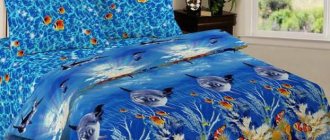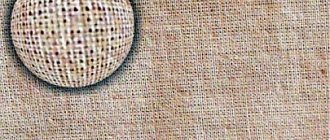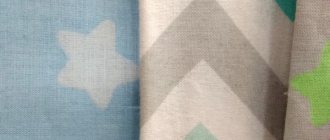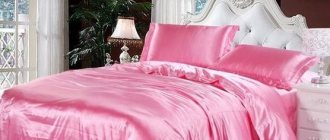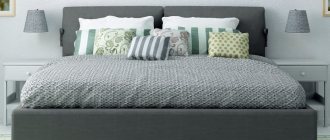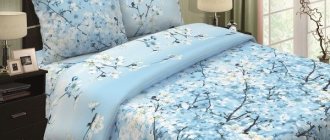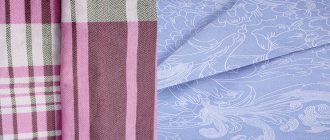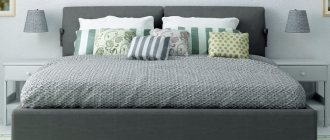Features of chintz fabric
What is chintz? This is cotton fabric of the simplest plain weave. The affordable cost of this material is determined precisely by the simplicity of the production technology. The density of such fabric is relatively low, but this feature gives the canvas softness and pliability.
It is known that chintz is a material that is painted in most cases using a surface method. Those. A printed pattern is created on the fabric. Pre-dyeing of fibers in this situation is unacceptable. Chintz is a fairly light and warm fabric with good hygroscopicity. Therefore, in most cases, light bed linen and summer clothing are made from it.
Advantages of chintz fabric
- environmental friendliness and naturalness;
- maximum safety for children, even newborns;
- wide range and rich range of colors;
- simple and easy care;
- affordable price;
- hypoallergenic;
- hygroscopicity;
- breathability;
- versatility.
As a rule, chintz is used for sewing light outerwear, as well as men's shirts and bed linen.
Production technology
The chintz is based on 100% cotton fiber.
Production stages:
- The fiber is made from the fuzzy seeds of the cotton plant;
- Raw materials are cleaned of all kinds of impurities at cotton gin plants.
- A strand is extracted from cotton inflorescences using a fiber separator and twisted into a thread. The thickness of the fibers is about 20-22 microns, but they are quite strong.
- After this, the chintz fabric is produced on conventional machines.
So that the pattern can be applied to the fabric, the canvas is initially produced in white. The pattern is applied to the surface using specially manufactured equipment. Today, boards with embossed ready-made patterns are most often used.
Patterns are also applied using rollers, on which the engraving is displayed manually. Each such shaft is pre-dipped in paint.
Today, special machines are used to produce chintz fabric and apply designs to it. It is precisely these machines that modern chintz production shops are equipped with. Thanks to the latest developments, the full production cycle can be reproduced without any difficulties.
Thanks to its properties, chintz is wonderfully colored.
Description and characteristics
Chintz, what kind of fabric is this? This is a natural material, most often its distinguishing feature is a small pattern on the surface.
The creation of chintz occurs in several stages. The result is a canvas with a density of 80 to 100 g/m*2. The brightness of the design is achieved by using modern chemical dyes. The main difference between calico and calico is in the density of the weave of the threads; calico is almost 2 times denser than calico. Chintz differs from cotton only in that the pattern on the surface is susceptible to fading when exposed to sunlight for a long time. For the most part, chintz is a type of cotton fabric.
What does chintz fabric look like? It is strong, identical on both sides. Plain weaving of threads gives the material density and strength; undyed chintz can also be used when sewing double-sided items. The front side can only be determined if a pattern is applied to the surface.
The natural composition of the threads can be determined quite easily using a lighter. The thread is set on fire, and as it burns you will smell the smell of burnt paper.
Advantages and disadvantages of chintz bed linen
Like any other sets, chintz bed linen of domestic or foreign production has its own certain advantages and disadvantages.
Let's look at the main advantages:
- Chintz bed linen is made only from natural materials without the use of synthetics;
- Almost any pattern and color can be displayed on the canvas;
- The material allows air to pass through well;
- Chintz absorbs moisture well;
- The fabric does not require maintenance;
- It should also be noted that the material is hypoallergenic. Therefore, chintz bedding is often purchased for young children with fragile immune systems and for allergy sufferers;
- Chintz dries quickly;
- Does not stretch;
- Easy to iron;
- The affordable cost of chintz bed linen is definitely an advantage.
Flaws:
- Calico bed linen shrinks after washing;
- The relatively low density of the fabric affects its strength;
- Bed linen made of chintz wrinkles a lot;
- After numerous washes, the original color of the fabric is lost.
- Seams may sag.
- After some time, pills appear on sheets, duvet covers and pillowcases;
- Low service life. Chintz can retain its original appearance only during the first two seasons of use.
LiveInternetLiveInternet
Just imagine, just yesterday they asked me so directly: what fabric is the best bed linen? Of course, the best underwear is made from natural fabrics. but you can find out about the properties of these fabrics on the pages of my blog and choose, so to speak, which sheet is closer to the body :)
So, the three pillars that form the basis of any natural textile industry are cotton, flax and, of course, silk.
And a wide range of fabrics are produced from cotton, each of which not only retains the positive properties of cotton, but also has its own unique advantages.
And, naturally, the very first one on this list is CHITCH!
Chintz happens:
1. printed - the surface of such chintz is decorated with printed designs. This type of chintz is most often used to make baby diapers, baby vests and nightgowns. The fabric is quite thin, pleasant to the body, breathable and absorbs moisture well.
2. madapolam is a bleached chintz with a smooth and hard surface. Bed linen is made from madapolam, but linen made from madopalam, although durable, is quite stiff, as if heavily starched.
3. plain dyed - it is used for making bed linen, summer dresses and bathrobes. The colors on this chintz are brighter, and the designs are more varied.
The density of chintz is small (70-103 g/m2) - it is a fairly thin fabric. Therefore, to give a “marketable appearance,” chintz bed linen is heavily starched, which reduces the hygroscopicity of the fabric. After purchasing chintz bed linen, you need to wash it to remove the starch that is used to treat the chintz.
It is precisely because of its low density that chintz quickly wears out, loses color, and pellets often form on chintz bed linen. Also, its disadvantages include its strong shrinkage, and this can lead to deformation of sheets and duvet covers. From my own experience, I know that sometimes after the first wash, the duvet cover “suddenly realizes that the blanket is too big for it.” The width of a standard chintz fabric is 80 cm, which means that chintz bed linen will always have a seam in the middle, which is not very comfortable to sleep on. In addition, chintz bed linen wrinkles easily and the bed quickly loses its neat appearance.
But, despite all the disadvantages, chintz bed linen also has a number of advantages: chintz is hypoallergenic, so it is ideal for children and allergy sufferers. Chintz perfectly allows air to pass through and absorbs moisture, which means sleeping on chintz is comfortable in both winter and summer. Bed linen made of chintz is the cheapest of all possible options, but given its short service life, it is not always profitable.
How to extend the service life of chintz bed linen?
The advice is simple: wash at a temperature of 30-40 degrees in the delicate wash mode and do not spin at high speeds. This will slightly extend the life of chintz bed linen.
How to care for chintz?
It is known that chintz is a fabric that is unpretentious in care. However, there are certain rules that must be followed:
- It is better to wash new cotton bed linen in cold water by hand. Then you can use the washing machine in delicate mode;
- It is not advisable to wash synthetic and natural fabrics at the same time. In this case, chintz may lose its softness;
- Before washing, the duvet cover must be turned inside out to remove accumulated dirt from the corners;
- All buttons and zippers must be fastened;
- The suitable water temperature for washing cotton bed linen is 40-50 degrees;
- To help preserve color, it is better to use regular powder without bleaches;
- When exposed to high temperatures, cotton fibers can become deformed and gradually break down. Therefore, it is advisable to iron bed linen through gauze or in a damp state;
- To dry, you need to hang the chintz on a line in the fresh air, but not in direct sunlight.
Comparison of chintz and other fabrics
Since chintz is often confused with calico and satin, we offer you a list of differences that will be useful when choosing fabric.
Satin, for example, differs by several criteria: it is denser, its texture resembles silk fabric, and in the sun’s rays the material shines and shimmers beautifully. Satin is more expensive.
Calico fabric is denser; additional weaving of threads gives a density of up to 130 g per square meter of fabric.
As you can see, this fabric can be used to make a large number of things and beautiful home accessories; it has many advantages and if you follow simple care rules it will last you a long time.
Popular manufacturers
The Shuya Calico factory is considered one of the largest in Russia. The manufacturer distributes its products throughout the country and also exports. This factory produces the best bed linen. The company is constantly expanding, today more than 30 branches have been opened in the country and abroad. The main distinguishing feature of this manufacturer is the cyclical production of products. Fabric is created at the factory, dyed, and then used to sew various products. Chintz bed linen is produced under the name Mod's.
“Ivanovo Calico” is a company that produces products from calico. The manufacturing process uses modern technologies that meet international quality standards. For more than 10 years, the company has been producing the best bed linen, characterized by a high level of quality and design.
History of creation
Chintz has a very interesting history; the first mention of this fabric dates back to the 11th century, when this material began to be produced in India, namely in the city of Bengal. Local traders from time to time brought chintz to other cities and countries, including Egypt and Europe. In the 17th century, this fabric became known in Europe, and at the beginning of the 19th century, multi-color manufacturing technology became available, thus expanding the possibilities of choice. At first, chintz was expensive and it was available only to emperors and kings, as well as their courtiers.
In addition, textile workshops began to appear in France, in which workers tried to make tracing paper on original patterns. However, over time, this was not necessary, since India revealed the secret of its production technology. In Great Britain, at first, chintz was banned; this was done because the locals could not withstand competition, so local authorities went to protect their fabric producers. Later, this fabric began to be produced independently in England.
In Russia, chintz was somewhat different: it was of high quality, magnificent, bright color, and an inimitable pattern on the fabric. The production of calico in Russia was simpler, so its cost was also low. This greatly contributed to the fact that this fabric began to spread quickly and widely throughout the country. At that time, absolutely all segments of the population, regardless of social status, made everyday clothes from chintz; some used this fabric for furniture production: furniture and even walls were upholstered with this material. Famous merchants in Russia producing chintz are Tretyakov, as well as Prokhorov and Morozov. The most popular fabrics were printed calicoes on a red background. In order to dye the fabric this color, a dye from moraine root was needed. The paint itself was applied according to the following principle: the paint broke up the color of the background itself and a new color beautifully appeared in this place.
In 1870, unusual ornaments and unique technology contributed to the fact that Russian chintz was known throughout the world. The merchant Baranov was able to organize a textile factory for the production of calico calico. Such chintz could depict bouquets of flowers, fruits, vegetables, as well as leaves and berries.
It should be noted that Russian kumachi looked as impressive and rich as possible, for example, the patterns symbolize majesty and luxury.
Today, chintz has become as accessible as possible: this fabric is incredibly practical, has several advantages, thanks to which it will not remain in its previous pleasant form for several years.
